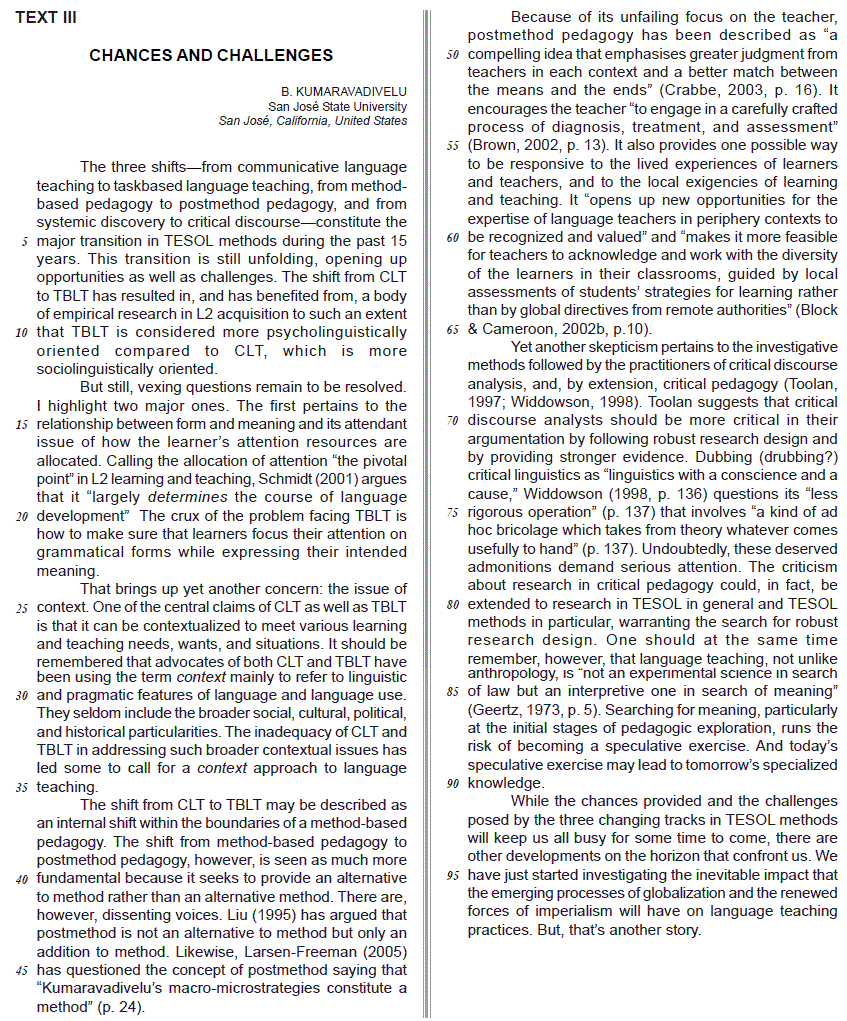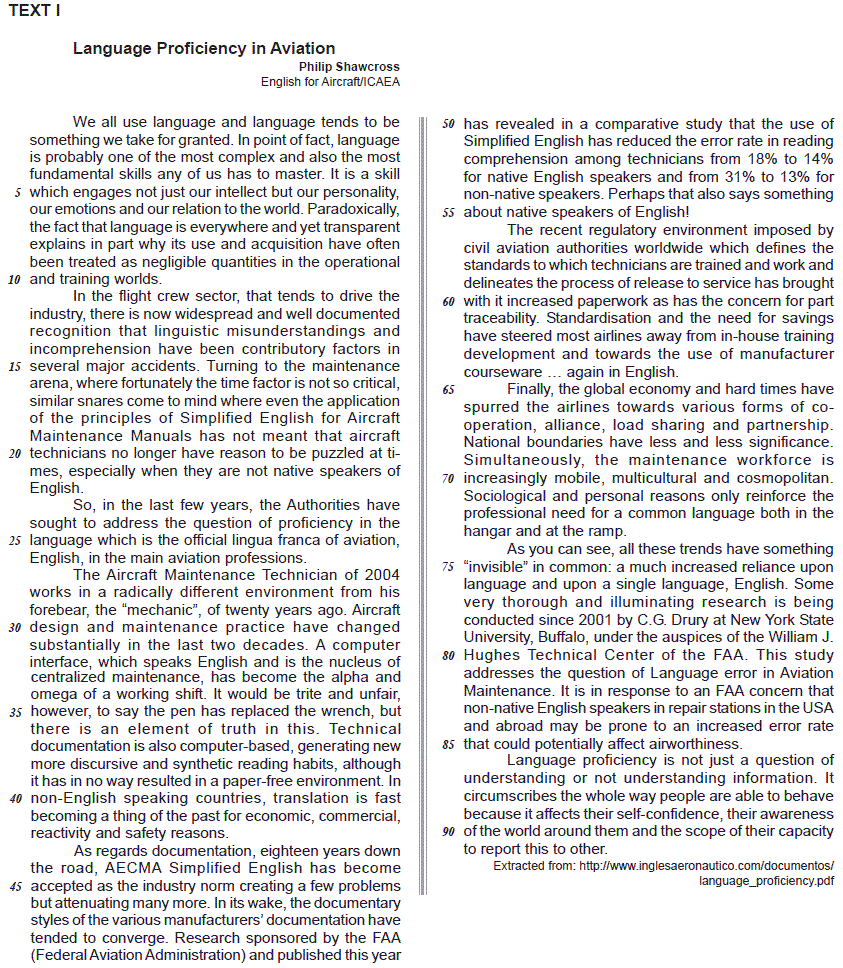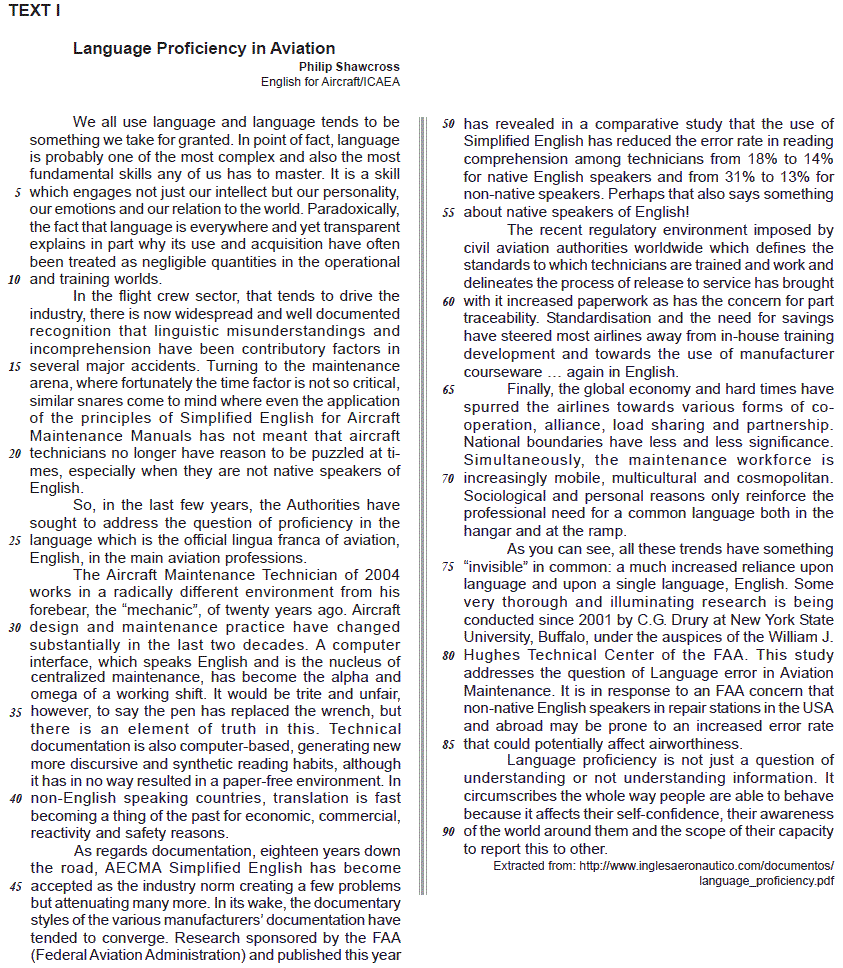Questões de Língua Inglesa do ano 2009
Lista completa de Questões de Língua Inglesa do ano 2009 para resolução totalmente grátis. Selecione os assuntos no filtro de questões e comece a resolver exercícios.

In The shift from method-based pedagogy to postmethod pedagogy, however, is seen as much more fundamental because it seeks to provide an alternative to method rather than an alternative method. (lines 38-41), the author implies that
- A.
alternative forms of learning are, ideally, not appropriate categories of method-based pedagogy.
- B.
TBLT can be said to be a shift toward alternative means of second/foreign language pedagogy.
- C.
all methods that emerged before were just alternative ways to teach fundamentals of the language.
- D.
the emergence of a postmethod paradigm is merely the consequence of expanding the boundaries of CLT.
- E.
the current teaching trend advocates for creative forms of learning that do not necessarily constitute a strict method.
The fragment It encourages the teacher to engage in a carefully crafted process of diagnosis, treatment, and assessment (Brown, 2002, p. 13). It also provides one possible way to be responsive to the lived experiences of learners and teachers, and to the local exigencies of learning and teaching. (lines 52-58) refers to pillars of postmethod pedagogy.
Which of the principles mentioned in this fragment are also representative of the core values of English for Academic Reading?
- A.
Diagram of learners needs and responding to the future experiences of teachers.
- B.
Sensitivity to the local exigencies of learning modes and strategies and treatment of learners.
- C.
Diagnosis of learners needs, assessment of learners outcomes and attention to the experiences of learners and teachers in the field.
- D.
Diagnosis and treatment of learners problems in the classroom environment with special regard to their overall health condition.
- E.
Localizing teachers and learners exigencies in experimenting with diagnosis, treatment and assessment of how they respond to their problems in life.
The author ends his text with the cliché But thats another story, because
- A.
we will be kept busy uncovering the stories that underlie the recent developments in TESOL methods.
- B.
the challenges of the three recent paradigms in ESL/ EFL methods will impose other personal stories of learning processes.
- C.
the situation of Language Teaching practices in imperialistic countries is quite different from the context he has analyzed in this article.
- D.
he has run out of space to comment further on the three changing tracks in TESOL methods and how they will impact globalization.
- E.
he does not really intend, in this article, to discuss the consequences of globalization and world Englishes on language teaching methodologies.
All of the sentences below, rephrasing ideas contained in the passage, contain mistakes in language use, from the point of view of standard written English, EXCEPT FOR:
- A.
Having started investigations, the emerging process of globalization is still not known.
- B.
Each of the advocates of CLT and TBLT can submit their ideas on contextualization.
- C.
Neither the postmethod-generation TESOLer nor the strong supporter of TBLT are aware of what determines the course of language teaching development.
- D.
The founding-father of critical pedagogy, together with critical discourse analysts, have been accused of being lenient in analyzing recent methodological trends.
- E. One reason for the skepticism towards critical pedagogy may have lain in the unwillingness of researchers to be more precise in their argumentation and research design.
The author comments that the TBLT approach is an offshoot of CLT. In another section of his full article, he comments that CLT was a principled response to the perceived failure of [previous methods]. Read the following claims on ELT methodology/approaches.
I - The Audiolingual methods proclaimed goal of fostering communicative capability in the learner was based on the presentation-practice-production sequence.
II - CLT emphasizes language competence in terms of social interaction, considering the main linguistic principles of speech act theory, functional grammar, communicative competence, introduced by Austin, Halliday and Dell Hymes, respectively.
III - CLT was a theoretically based approach that reinforced the emphasis on the linguistic structures of the target language, as supported by the Audiolingual method.
IV - The Audiolingual method conveyed a largely structural orientation that relied on a rendering of pattern practices with pseudo-meaningful exchanges of scripted dialogues.
V - The Grammar-Translation method was grounded on the principles of American structuralist linguistics and behaviorist psychology in language teaching methods and materials.
Mark the alternative that contains only correct claims.
- A.
I, II and IV.
- B.
I, III and IV.
- C.
II, III and V.
- D.
I, II, III and V.
- E.
II, III, IV and V.
In the final section of his article, Kumaravadivelo writes:
Weve come a long way declared Brown (1991, p. 257) as he concluded his essay for the 25th anniversary issue of TESOL Quarterly. He was actually referring to the progress the TESOL profession was making during the 1970s and 80s in achieving desired goals such as shifting its focus from product-oriented teaching to process-oriented teaching, and from a rigid curriculum to a more flexible one. Even those modest shifts, according to him, had created a new state of awareness in the profession. Considering the more significant trend-setting shifts that have marked the 1990s, we can claim with some justification that we have now reached a much higher level of awareness. We might even say, with a good measure of poetic license, that we have moved from a state of awareness toward a state of awakening.
Which of the following statements could NOT be considered a shift from awareness to awakening?
- A.
We have awakened to the multiplicity of learner identities and the complexity of teacher beliefs.
- B.
We have been awakened to the necessity of making methods-based pedagogies more sensitive to local exigencies.
- C.
We have been awakened to shift our focus from productbased teaching practice to a process-based one, in which our curriculum is more flexible.
- D.
We have been awakened to the opportunity afforded by postmethod pedagogies to help practicing teachers develop their own theory of practice.
- E.
We have been awakened to the vitality of macrostructuressocial, cultural, political, and historicalthat shape and reshape the microstructures of our pedagogic enterprise.
In his article, Kumaravadivelo also mentions that TESOLers have now reached a state of consciousness about the central issues that must govern teaching practices. Yet, he says that:
Admirable intentions need to be translated into attainable goals, which, in turn, need to be supported by actionable plans. I hope that the person who will be writing a state-ofthe- art essay for the golden jubilee volume of TESOL Quarterly in 2016 will be able to narrate a possible transition from awakening to attainment. After all, the end of all awakening must be the beginning of attainment.
The expression from awakening to attainment can be appropriately paraphrased as
- A.
from sweating to learning
- B.
from knowing to doing
- C.
from beginning to end
- D.
from head to heels
- E.
from here on

The main purpose of this text is to
- A.
reinforce the need to define English as the lingua franca in the aviation sector.
- B.
discuss the importance of mastering English to find jobs in the aircraft industry.
- C.
argument for the relevance of English language fluency in most professions worldwide.
- D.
sustain that the language of aviation, is primarily English, in both operations and maintenance.
- E. advocate for the use of AECMA Simplified English in all FAA documentation for native and non-native speakers.

According to paragraph 2, it is correct to say that
- A.
aircraft technicians and flight personnel are submitted to equal time pressure when they need to react to English language commands.
- B.
both airline crews and maintenance personnel are subject to English language misunderstandings that can cause critical mishaps.
- C.
aircraft maintenance personnel usually seem puzzled in discussions with native speakers about the need to use principles of Simplified English.
- D.
it is widely known that several major accidents have been caused by linguistic misunderstandings during aircraft maintenance procedures.
- E. it is interesting to know that linguistic misunderstandings and incomprehension are also the cause of critical time constraints in maintenance operations.

Choose the only alternative that the author does NOT mention in support of the idea that the professional environment of aircraft maintenance crews nowadays is different from that of their peers in the past.
- A.
Computers have gained the factory floor and have been eliminating many specialized technicians.
- B.
Simplified English norms are adopted as a standard for most maintenance manuals and aircraft documentation.
- C.
Most maintenance documentation is accessed through computer databases and not usually available in print.
- D.
Manufacturers are now the leading source of courseware that will train maintenance crew to handle new equipment.
- E.
Globalization and the expansion of worldwide partnerships in the aviation industry have impacted the maintenance workforce.


